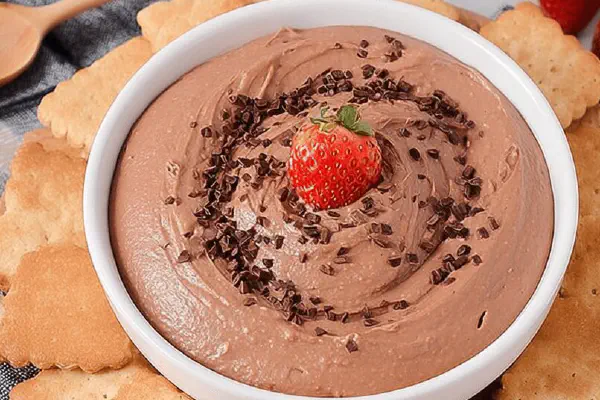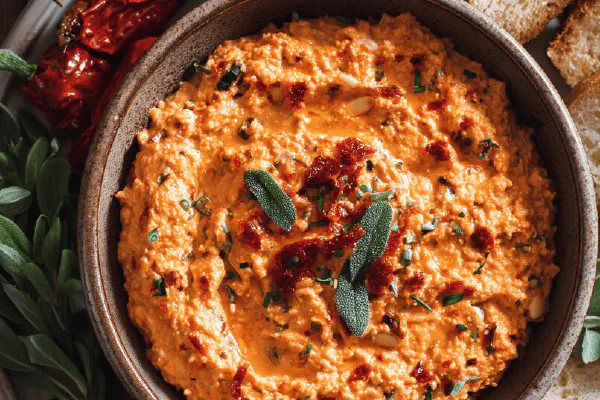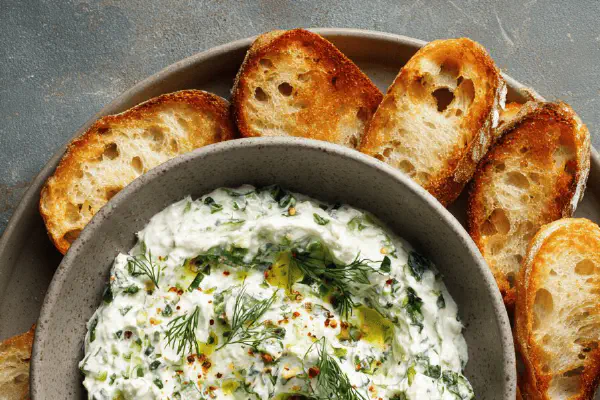Featured Recipe
Labneh with Za'atar Twist

By Kate
"
Homemade strained yogurt cheese, labneh, made by draining Greek yogurt mixed with salt for thicker tangy richness. Uses a yogurt maker strainer but any fine sieve works. Draining time adjusted slightly for firmer texture. Salt level cut by one third, replaced with a little garlic powder for a savory edge. Drizzle olive oil and sprinkle za’atar blend instead of sumac for aromatic finish. Keeps refrigerated up to 10 days. Simple, flexible, yields creamy, spreadable tang that’s rustic and fresh.
"
Prep:
10 min
Cook:
0 min
Total:
Serves:
1 1/3 cups
Middle Eastern
yogurt recipes
dip
sinful spreads
cream cheese alternative
Introduction
Labneh, essentially strained yogurt, thrives on the balance of salt, cold, and drainage. The slower it drains, the creamier it gets. Expect thick, spreadable tang that doesn’t scream sour or dry up. Start with thick Greek yogurt; thinner yogurt makes weak texture — patience required. Let gravity do the work, not squeezing or pressing, or you’ll get dry curds instead of luscious spread. The magic: whey drains slowly, you watch color and texture shift subtly, not abruptly — dulling shine, firming body. A drizzle of good olive oil and za’atar wakes it up, lifting flavors to new heights. Keep it refrigerated. No fridge, no joy — acid builds fast in warm air. Resistant to fads, labneh’s simplicity keeps it kitchen-proven for decades. No shortcuts, no fillers.
Ingredients
About the ingredients
Greek yogurt is your starting point. Full-fat gives creamier, richer mouthfeel but low-fat can work with slightly less draining time so texture stays smooth. Salt is crucial; it extracts whey and balances flavor. Garlic powder boosts savory tone without overpowering. Za’atar is traditional but dried oregano or thyme work too. Olive oil should be fruity and robust – a quick splash enhances aroma and texture. Using cheesecloth or a clean kitchen towel helps speed draining. If you don’t have a yogurt maker strainer, stack one sieve over another or use a fine colander lined with lint-free cloth. Adjust draining time by feel – too wet is sloppy, too dry crumbly.
Method
Technique Tips
Starting with cold strainer reduces condensation and drip mess in fridge. Mixing salt evenly is critical; uneven dissolving causes watery pockets or bland spots. If pressed, cover yogurt lightly and keep airtight; exposed yogurt may absorb fridge odors or dry out edges. Drain time is flexible; check after 18 hours by pressing with spatula – should resist but still scoop without crumbling. Resist stirring, which breaks structure and adds moisture back. Whey is a useful byproduct – freeze it in ice cube trays for savory stock or use in batters for extra tang. Garnishing with za’atar or herbs adds flavor and textural contrast but keep it simple. Too many toppings mask creamy base. Store labneh cold and covered in glass or plastic container to prevent absorbing smells.
Chef's Notes
- 💡 Use full-fat Greek yogurt for richness; low-fat works too but adjust draining time. Salt is not just flavor, crucial for extracting moisture. Garlic powder? Essential for layers of flavor.
- 💡 Cold strainer? Helps keep texture intact. Wrap yogurt lightly if fridge odors are an issue. Texture test? Press gently with spatula – should resist a bit. Drain longer if too wet.
- 💡 Disposing whey? Consider it liquid gold for smoothies or bread. Add it in sauces for extra tang. Don't toss it; it’s useful. Check on texture after 18 hours. Adjust drainage time based on feel.
- 💡 Za'atar adds woodsy essence, but fresh herbs or what’s on hand might surprise. Experiment with toppings; just don't overshadow labneh. Pine nuts or mint? Great contrast.
- 💡 Storing in glass containers prevents odors. Airtight ensures it stays fresh, not exposed to air. Keep your labneh cold. No fridge? Texture changes; gets funky.
Kitchen Wisdom
How to adjust draining time for firmer texture?
Watch the yogurt closely. 18-22 hours is a range; longer = thicker. Check texture and use feel.
What if labneh turns crumbly?
Happens if drained too long. Less time next batch; keep a close eye. Moisture content is key.
Can I substitute Greek yogurt?
Yes, but choose thicker types. Regular yogurt might not yield the same consistency. Draining time changes, add 2 hours to start.
How long can I store labneh?
Up to 10 days in fridge. After that, flavors intensify; texture may change. Use it before 10 days for best results.



